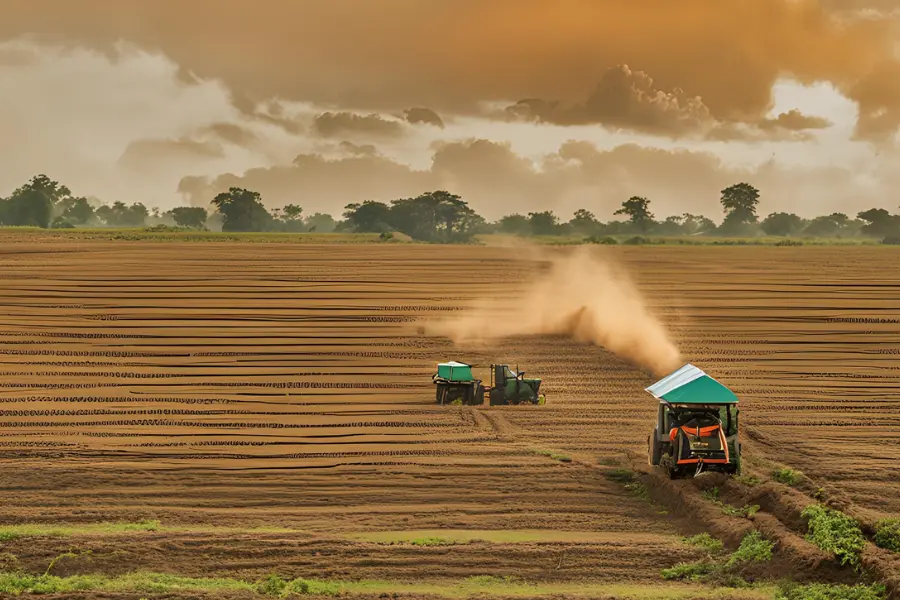Climate Change Impacts on Agricultural Productivity
Climate change is a growing global concern impacting various sectors, particularly Agriculture. As we study unpredictable weather patterns, rising temperatures, and extreme climatic events, the need for precise, data-driven analysis in agriculture has become more demanding. Understanding the complex relationships between climate change and agricultural productivity is essential for developing better farming practices, ensuring food security, and sustaining economic growth. In this article, we will come across how data analytics plays a vital role in assessing and moderating the impacts of climate change on agricultural productivity.

The Relation Between Climate Change and Agriculture
Agriculture is highly sensitive to climate variations. Factors such as temperature, precipitation, and CO2 levels significantly influence crop growth, soil health, and pest dynamics. Climate change intensifies these variables, leading to a range of adverse effects:
Temperature Fluctuations
Increased temperatures can accelerate crop maturation, reducing yield quality and quantity. Conversely, extreme cold temperature can damage crops that are unadaptable to frost.
Precipitation Patterns
Changes in rainfall patterns, including prolonged droughts and intense storms, disrupt water availability for crops, affecting their growth cycles and productivity.
Pest and Disease Addition
Warmer temperatures and altered humidity levels create conducive environments for pests and diseases, which can destroy crops and reduce agricultural output.
The Role of Data in Climate-Agriculture Analysis
Data analytics offers powerful tools to understand and address the impacts of climate change on agriculture. By using large datasets and advanced analytical techniques, we can gain actionable insights to improve agricultural practices and mitigate risks. Here are several ways data analytics is transforming climate-agriculture analysis:
Climate Modeling and Forecasting
Data-driven climate models are essential for predicting future climate scenarios and their potential impacts on agriculture. These models combine historical climate data, current weather patterns, and greenhouse gas emission trajectories to forecast temperature, precipitation, and extreme weather events. For instance, the Intergovernmental Panel on Climate Change (IPCC) uses sophisticated models to project climate trends, helping policymakers and farmers prepare for future conditions.
Crop Simulation Models
Crop simulation models use data on soil conditions, crop physiology, and climate variables to predict how crops will respond to different climatic scenarios. These models can estimate yield outcomes under varying temperature and rainfall patterns, enabling farmers to select the most suitable crops and planting times. Tools like the Decision Support System for Agrotechnology Transfer (DSSAT) are widely used to simulate crop growth and development, providing valuable insights for optimizing agricultural productivity.
Remote Sensing and Geographic Information Systems (GIS)
Remote sensing technologies, such as satellite imagery and drones, collect real-time data on crop health, soil moisture, and land use changes. When linked with GIS, this data helps in mapping and monitoring agricultural landscapes, assessing the extent of climate impacts, and identifying vulnerable areas. For example, satellite data can detect drought conditions early, allowing for timely interventions to prevent crop losses.
Phenology Tracking
Phenology, the study of periodic plant and animal life cycle events, is crucial for understanding the impact of climate change on crop development stages. Data analytics enables detailed tracking of phenological events such as flowering, fruiting, and harvest timings. By monitoring these changes, farmers and researchers can adapt agricultural practices to shifting climate conditions, ensuring optimal crop yields and quality.
Big Data and Machine Learning
Big data analytics and machine learning algorithms are revolutionizing how we analyze climate and agricultural data. These technologies can process vast amounts of data from diverse sources, including weather stations, IoT sensors, and historical crop records. Machine learning models can identify patterns and correlations that human analysts might overlook, providing predictive insights for crop yield, pest outbreaks, and optimal resource allocation. Companies like IBM and Microsoft are leveraging big data to offer precision agriculture solutions, enhancing decision-making processes for farmers.
Carbon Footprint Reduction
Data analytics supports efforts to reduce the carbon footprint of agricultural practices. By analyzing data on greenhouse gas emissions from various farming activities, analysts can identify high-emission practices and implement more sustainable alternatives. This contributes to climate change moderation and promotes environmentally friendly farming practices.
Economic and Policy Analysis
Data analytics is also useful in economic and policy analysis related to climate change and agriculture. By evaluating the economic impacts of climate scenarios, analysts can propose cost-effective adaptation strategies. Policies such as crop insurance schemes, subsidies for climate-resilient crops, and investment in sustainable farming practices can be designed and assessed using robust data analytics.
Real-World Applications and Case Studies
Several real-world applications highlight the significance of data analytics in combating the effects of climate change on agriculture:
India's Crop Yield Forecasting
Different Indian Agricultural Organizations like IARI, NAARM, CIAE, etc. use data analytics to predict crop yields and assess drought impacts. By integrating weather data, soil health information, and historical yield records, these organizations can provide timely advisories to farmers, enhancing their adaptive capacity.
Africa's Climate Smart Agriculture
In Africa, initiatives like the Africa Climate-Smart Agriculture Alliance utilize data analytics to promote sustainable farming practices. By analyzing climate risks and crop suitability, these initiatives help farmers adopt techniques that enhance productivity.
United States’s Climate Adaptation Strategies
In the U.S., the USDA (U.S. Department of Agriculture) employs data-driven models to evaluate climate impacts on different agricultural regions. These models inform strategies for crop diversification, water management, and soil conservation, ensuring long-term agricultural sustainability.
Active Events
3 Must Have Projects On your CV to Get into Data Analysis
Date: Feburary 25, 2025 | 7:00 PM(IST)
7:00 PM(IST) - 8:10 PM(IST)
2753 people registered
Data Scientist Challenges One Should Avoid
Date: Feburary 25, 2025 | 7:00 PM (IST)
7:00 PM (IST) - 8:10 PM (IST)
2753 people have registered
Bootcamps
Data Analyst Bootcamp
- Duration:8 weeks
- Start Date:October 5, 2024
Digital Marketing Bootcamp
- Duration:8 weeks
- Start Date:October 5, 2024
